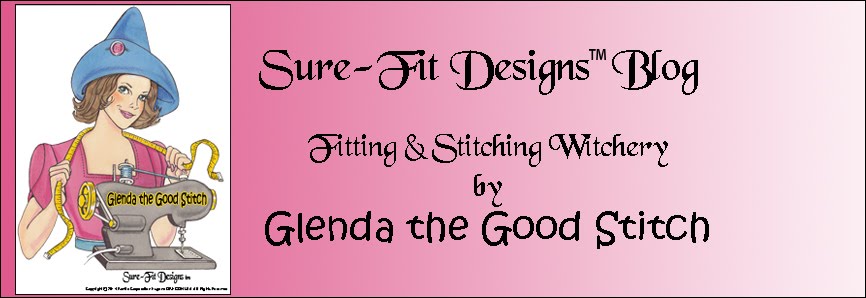If you have a fairly short front crotch length measurement and you have a relatively thick waist, when drawing the pants pattern, you may find that your numbers 'fall off the Master Pattern Grid lines'. This situation may occur when you are establishing the intersecting point for your waist measurement and front crotch length measurement on the Pants Front Waist/Crotch Grid. In other words, the grid lines stop before your two numbers of waist measurement and front crotch length measurement have a chance to intersect. These photos show and example of the type of body shape where this may occur.
If this occurs, simply extend your appropriate grid lines straight down. The waist measurement line (attached to your waist measurement number) will be drawn straight down. The front crotch length measurement number will be extended downward but continuing on in its current angle and slope.
See the example diagram below where the person's waist measurement is 46" (116.6cm) and the front crotch length is 11 1/2" (29.2 cm). Note how these lines have been extended and shown in continuous RED lines. The BLUE dot represents where the two lines intersect. This is where you would mark your placement dot for your CF waist measurement. This dot, of course, would then connect (in either a straight or curved line) to your front side waist measurement dot. And you would then continue to proceed to mark in your Dart tip and then your Front Crotch Pt. #1 and Pt. #2. These steps are found in your Pants Kit instruction book, page 9, steps 9 and 10.
Glenda...the Good Stitch!
If this occurs, simply extend your appropriate grid lines straight down. The waist measurement line (attached to your waist measurement number) will be drawn straight down. The front crotch length measurement number will be extended downward but continuing on in its current angle and slope.
See the example diagram below where the person's waist measurement is 46" (116.6cm) and the front crotch length is 11 1/2" (29.2 cm). Note how these lines have been extended and shown in continuous RED lines. The BLUE dot represents where the two lines intersect. This is where you would mark your placement dot for your CF waist measurement. This dot, of course, would then connect (in either a straight or curved line) to your front side waist measurement dot. And you would then continue to proceed to mark in your Dart tip and then your Front Crotch Pt. #1 and Pt. #2. These steps are found in your Pants Kit instruction book, page 9, steps 9 and 10.
Fine Tuning Your Pattern's Crotch Lengths - if Necessary
Once you have drawn your Back and Front Crotch lengths, also make sure you measure the finished lengths. Since you are measuring a curve, remember to stand the tape measure on edge and walk the tape around the stitching line to ensure accurate length measurements. The instructions and illustrations for this step are found in your Pants Kit instruction book on page 10, #13 - Fine Tuning Crotch Lengths.
Glenda...the Good Stitch!














